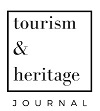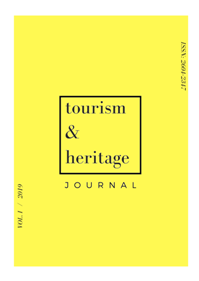El patrimoni immaterial a través de propostes de mediació en ciutats turístiques: el cas del districte Sarrià-Sant Gervasi de Barcelona.
DOI:
https://doi.org/10.1344/THJ.2019.1.4Paraules clau:
Barcelona, itinerari turístic, mediació, patrimoni immaterial, posada en valor.Resum
En nombroses ocasions, el patrimoni cultural immaterial pot ser indesxifrable per a les persones que el volen gaudir a causa de la seva intangibilitat. És per això que el present article pretén trencar amb aquesta barrera a través de tres propostes de mediació per a una ruta turístico-cultural al districte de Sarrià - Sant Gervasi (Barcelona). A més, també es busca descentralitzar l’activitat turística de la ciutat augmentant l’oferta cultural a zones menys centrificades. Concretament, l’itinerari té l’objectiu d’explicar la història d’aquest districte a través dels seus personatges més emblemàtics, destacant elements patrimonials, fets, curiositats i anècdotes del barri. Les tres propostes de mediació són: una visita teatralitzada on els participants són els actors, una visita amb codis QR a través dels quals es plantegen reptes als usuaris i una visita nocturna de terror que finalitza amb un escape room. Per acabar, es proposen futures línies de recerca vinculades per una banda a les ciutats i, per l’altra, a la proposta concreta.Referències
Ajuntament de Barcelona. PEUAT. http://ajuntament.barcelona.cat/pla-allotjaments-turistics/ca/ (Recuperat el 19 de febrer de 2019).
Ajuntament de Barcelona. Pla estratègic. https://ajuntament.barcelona.cat/turisme/ca/pla-estrategic
(Recuperat el 20 de febrer de 2019).
Ajuntament de Barcelona. Turisme. https://ajuntament.barcelona.cat/turisme/ca/estadistiques_enquestes (Recuperat el 19 de febrer de 2019).
Ashworth, G. i Page, S. (2011). Urban tourism research: Recent progress and current paradoxes. Tourism Management, 32, 1-15.
Cabrera, J., Galella, F. i Llevot, C. (2014). Estan prou preparades les destinacions actuals per acollir els seus visitants? (bachelor’s thesis). CETT-UB, Barcelona.
Casanovas, O. (2017). Turismo y convivencia ciudadana. A Coma, L. i Santacana, J. (coord), Ciudad educadora y turismo responsable (pp. 135-141). Gijón: Ediciones Trea.
Casanovas, A. i Arcos, J. (2017). Protección del patrimonio y su contexto: de la conservación a la preservación. A Coma, L. i Santacana, J. (coord), Ciudad educadora y turismo responsable (pp. 213-230). Gijón: Ediciones Trea.
Coma, L. i Conill, M. (2017) Buenas prácticas de turismo responsable desde y en las ciudades educadoras. A Coma, L. i Santacana, J. (coord), Ciudad educadora y turismo responsable (pp. 161-174). Gijón: Ediciones Trea.
Coma, L. i Santacana, J. (2010). Ciudad educadora y patrimonio. Cookbook of heritage. (1a ed.). Gijón: Ediciones Trea.
Euromonitor International. (2019). Top 100 City Destinations 2018. http://go.euromonitor.com/rs/805-KOK-719/images/wpTop100CitiesEN_Final.pdf?mkt_tok=eyJpIjoiTlRZNE1tWmpZVFUyWmpWbSIsInQiOiI5SDhtU0FcL2dHVzV6d3BPdUYyMk9iZGNcLzdcL0F4SU9WWVVzMjdlcVlRUVgwdlpLV0FpZER0Y1Q4UCtBK2ZISVdQZjVmRDhHRFlPTWFtODZ2NFhNSXpKNjlEMGtWSkFseDcwWW1pOGxUdjBKcHdwc2lKRmttRWZ1K2NhWTN5MXRCVCJ9
Fontal, O. (2013). La educación patrimonial. Del patrimonio a las personas. (1a ed.). Gijón: Ediciones Trea.
Garcia, A., Linaza, M., Gutierrez, A. i Garcia, E. (2018). Gamified mobile experiences: smart technologies for tourism destinations. Tourism Review, 74, (1), 30-49.
Guitart, N. (2018). De la Turismofobia a la Convivencia Turística: El Caso de Barcelona. Análisis Comparativo con Ámsterdam y Berlín. ARA: Journal of Tourism Research, 8, (2), 25-34.Imbert-Bouchard, D. (2017). El turismo y su componente geográfico y territorial. A Coma, L. i Santacana, J. (coord), Ciudad educadora y turismo responsable (pp. 123-129). Gijón: Ediciones Trea.
Llonch, N. i Santacana, J. (2015). El patrimonio cultural inmaterial y su didáctica. (1a ed.). Gijón: Ediciones Trea.
López Palomeque, F. (2015). Barcelona, de ciutat amb turisme a ciutat turística. Documents d’Anàlisi Geogràfica, 61 (3).
Niemelä, T. (2010). Nature and Soft Adventure Tourism (bachelor’s thesis). Lathi University of Applied Science, Lathi.
Observatori Dades Culturals Barcelona. http://barcelonadadescultura.bcn.cat/equipaments/(Recuperat el 20 de febrer de 2019).
OMT. (6 de novembre de 2017). El turismo internacional hacia otro año de crecimiento. OMT. Recuperat el 20 de febrer de 2019. http://media.unwto.org/es/press-release/2017-11-07/el-turismo-internacional-hacia-otro-ano-de-crecimiento
OMT & IPSOS. (2019). Estudio global sobre la percepción de los residentes hacia el turismo urbano: impacto y medidas. Recuperat el 20 de febrer de 2019. http://cf.cdn.unwto.org/sites/all/files/docpdf/omtipsosestudioglobalresumen.pdf
Ruiz-Ballesteros, E., Hernández, M., Coca, A., Cantero, P. i del Campo, A. (2008). Turismo comunitario en Ecuador. Pasos, 6, (3), 399-418.
Solima, L. i Izzo, F. (2017). QR Codes in cultural heritage tourism: new communications technologies and future prospects in Naples and Warsaw. Journal of Heritage Tourism, 13, (1), 115-117.
Tilden, F. (1977). Interpreting Our Heritage. Chapel Hill: University of North Carolina Press.
UNESCO, (2003), Convention for the Safeguarding of the intangible cultural heritage, UNESCO, Paris.
UNESCO (2014). Indicadores UNESCO de cultura para el desarrollo. https://es.unesco.org/creativity/sites/creativity/files/digital-library/cdis/Patrimonio.pdf
Van Es, N. i Reijnders, S. (2016). Making sense of capital crime cities: Getting underneath the urban facade on crime-detective fiction tours. European Journal of Cultural Studies, 21(4), 502–520.
Descàrregues
Publicades
Com citar
Número
Secció
Llicència
L'autor/a que publica en aquesta revista està d'acord amb els termes següents:- L'autor/a conserva els drets d’autoria i atorga a la revista el dret de primera publicació de l’obra.
- Els textos es difondran amb la llicència de Reconeixement de Creative Commons, la qual permet compartir l’obra amb tercers, sempre que en reconeguin l’autoria, la publicació inicial en aquesta revista i les condicions de la llicència.




